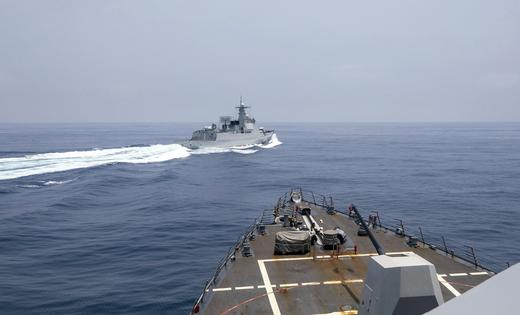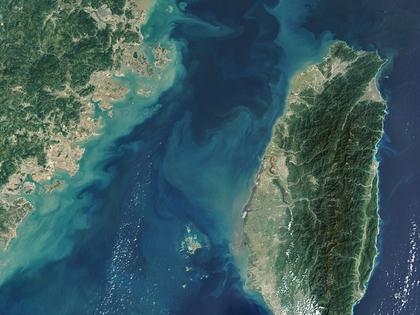US, Chinese warships' near miss in Taiwan Strait hints at ongoing troubled diplomatic waters, despite chatter about talks
Published in Political News
An encounter in which a Chinese naval ship cut across the path of a U.S. destroyer in the Taiwan Strait on June 3, 2023, has both Beijing and Washington pointing fingers at each other.
It was the second near miss in the space of just a few weeks; in late May a Chinese plane crossed in front of an American surveillance aircraft above the South China Sea.
Meredith Oyen, an expert on China-U.S. relations at the University of Maryland, Baltimore County, helps explain the context of the recent encounters and how they fit within growing tensions between the two countries.
It came as the U.S. and Canada were conducting a joint transit of the Taiwan Strait – a body of water that separates the island of Taiwan from mainland China. Washington does these transits fairly regularly, but not usually with another country.
As the American destroyer USS Chung-Hoon and Canadian frigate HMCS Montreal traveled up the channel, a Chinese warship passed and veered across the U.S. vessel’s path at a pretty close range, according to U.S. Indo-Pacific Command. As a result, the USS Chung-Hoon had to reduce its speed to avoid a collision.
The U.S. has characterized the incident as an “unsafe” maneuver on behalf of the Chinese and protested that it took place in international waters.
The perspective from Beijing is that the U.S. and Canada were “deliberately provoking risk” by sailing a warship through Chinese waters.
The United Nations Convention on the Law of the Sea stipulates that a country’s “territorial waters” extend 12 nautical miles off its coast – anything above or on the sea in that zone is considered part of the country’s territory. After that, there is a further 12-mile “contiguous zone,” over which a coastal state has rights to prevent infringement of the country’s “customs, fiscal, immigration or sanitary” laws, according to the UN treaty.
Complicating matters, Beijing – a signatory to the Convention on the Law of the Sea, unlike the U.S. – claims the island of Taiwan as part of China. Under the U.N. convention’s stipulations, this would also mean Beijing can claim the 12 miles of territorial waters off Taiwan’s coast, as well as a 12-mile contiguous zone.
But even at its narrowest point, the Taiwan Strait is around 86 miles wide. So even accepting Beijing’s territorial claim, there would, under U.N. law, be a channel that falls outside its territory.
Nonetheless, Beijing claims sovereignty of the entirety of the waters between Taiwan and China under its exclusive economic zone.
Despite not signing the U.N. Convention on the Law of the Sea, the U.S. abides by the 12-mile standard and views a large chunk of the strait as international waters.
The United States has regularly sailed vessels through the Taiwan Strait for decades. At times of tension – notably during the Korean War and Taiwan Straits crises of 1954-55, 1958 and 1962 – the U.S. has deployed destroyers in the channel as a deliberate show of military strength and support for Taiwan.
This continued after the U.S. normalized relations with China in 1978 until today, with few incidents that caused the level of tit-for-tat recriminations such as in the latest case. But there have been “near misses” in the sky, noticeably the recent airplane-to-airplane encounter that preceded this incident.
What we have increasingly seen, though, is Chinese officials protest these Taiwan Strait transits by the U.S. And the number of protests by China has increased in recent years, as tension over Taiwan has increased.
The past few years have seen a deterioration in U.S.-China relations. There have been no direct, high-level military talks between the two countries since 2019. Meanwhile, relations have further soured on other topics, such as the ongoing trade war, the issue of Taiwan and allegations relating to the spread of COVID-19.
At times of better relations between Beijing and Washington, military transits such as the one in the Taiwan Strait might have gone largely unremarked upon. But amid such tensions, any incident is elevated to the level of uniquely bad provocation.
The broader context is that the U.S. regularly holds military drills and “freedom of navigation” operations in the South China Sea. These activities are used by the U.S. Department of Defense to demonstrate that the U.S. has a right to sail in waters it views as international, even if they are claimed by nation states.
The concern is that with tensions as they are – and with no official direct line of dialogue – a near miss during such a drill, or, worse still, an actual collision, could escalate beyond control, leading to military conflict.
The near miss came at a curious time – while top diplomats and defense chiefs from both the U.S. and China were attending the Shangri-La Dialogue in Singapore.
At that security summit, U.S. Defense Secretary Lloyd Austin shook the hand of his Chinese counterpart, Li Shangfu. But they didn’t hold a side meeting – as some observers had hoped.
Austin also underscored the importance of the Taiwan Strait to Washington: “The whole world has a stake in maintaining peace and stability in the Taiwan Strait. The security of commercial shipping lanes and global supply chains depends on it. And so does freedom of navigation worldwide. Make no mistake: conflict in the Taiwan Strait would be devastating.”
Washington has suggested that it wants to resume official talks with Beijing. Incidents such as that in the Taiwan Strait underscore the potential need for such discussions, if only to avoid encounters escalating into something more serious.
This article is republished from The Conversation, an independent nonprofit news site dedicated to sharing ideas from academic experts. If you found it interesting, you could subscribe to our weekly newsletter.
Read more:
The US is about to blow up a fake warship in the South China Sea – but naval rivalry with Beijing is very real and growing
Biden again indicates that US will defend Taiwan ‘militarily’ – does this constitute a change in policy?
Meredith Oyen does not work for, consult, own shares in or receive funding from any company or organization that would benefit from this article, and has disclosed no relevant affiliations beyond their academic appointment.


























































Comments